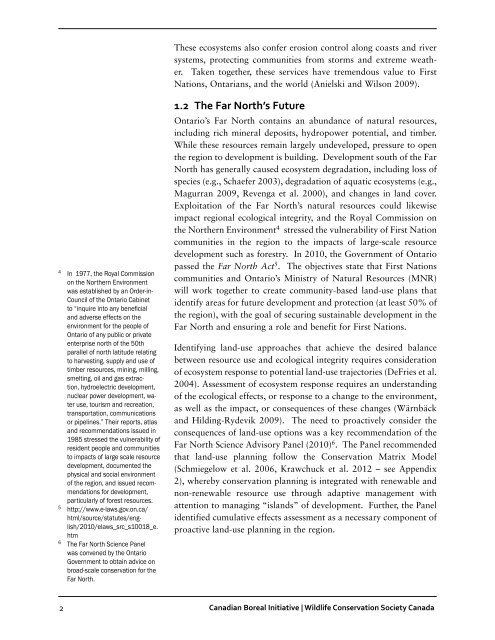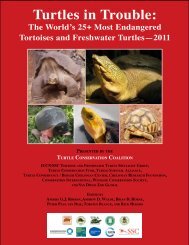You also want an ePaper? Increase the reach of your titles
YUMPU automatically turns print PDFs into web optimized ePapers that Google loves.
These ecosystems also confer erosion control along coasts and river<br />
systems, protecting communities from storms and extreme weather.<br />
Taken together, these services have tremendous value to First<br />
Nations, Ontarians, and the world (Anielski and Wilson 2009).<br />
4<br />
In 1977, the Royal Commission<br />
on the Northern Environment<br />
was established by an Order-in-<br />
Council of the Ontario Cabinet<br />
to “inquire into any beneficial<br />
and adverse effects on the<br />
environment for the people of<br />
Ontario of any public or private<br />
enterprise north of the 50th<br />
parallel of north latitude relating<br />
to harvesting, supply and use of<br />
timber resources, mining, milling,<br />
smelting, oil and gas extraction,<br />
hydroelectric development,<br />
nuclear power development, water<br />
use, tourism and recreation,<br />
transportation, communications<br />
or pipelines.” Their <strong>report</strong>s, atlas<br />
and recommendations issued in<br />
1985 stressed the vulnerability of<br />
resident people and communities<br />
to impacts of large scale resource<br />
development, documented the<br />
physical and social environment<br />
of the region, and issued recommendations<br />
for development,<br />
particularly of forest resources.<br />
5<br />
http://www.e-laws.gov.on.ca/<br />
html/source/statutes/english/2010/elaws_src_s10018_e.<br />
htm<br />
6<br />
The Far North Science Panel<br />
was convened by the Ontario<br />
Government to obtain advice on<br />
broad-scale conservation for the<br />
Far North.<br />
1.2 The Far North’s Future<br />
Ontario’s Far North contains an abundance of natural resources,<br />
including rich mineral deposits, hydropower potential, and timber.<br />
While these resources remain largely undeveloped, pressure to open<br />
the region to development is building. Development south of the Far<br />
North has generally caused ecosystem degradation, including loss of<br />
species (e.g., Schaefer 2003), degradation of aquatic ecosystems (e.g.,<br />
Magurran 2009, Revenga et al. 2000), and changes in land cover.<br />
Exploitation of the Far North’s natural resources could likewise<br />
impact regional ecological integrity, and the Royal Commission on<br />
the Northern Environment 4 stressed the vulnerability of First Nation<br />
communities in the region to the impacts of large-scale resource<br />
development such as forestry. In 2010, the Government of Ontario<br />
passed the Far North Act 5 . The objectives state that First Nations<br />
communities and Ontario’s Ministry of Natural Resources (MNR)<br />
will work together to create community-based land-use plans that<br />
identify areas for future development and protection (at least 50% of<br />
the region), with the goal of securing sustainable development in the<br />
Far North and ensuring a role and benefit for First Nations.<br />
Identifying land-use approaches that achieve the desired balance<br />
between resource use and ecological integrity requires consideration<br />
of ecosystem response to potential land-use trajectories (DeFries et al.<br />
2004). Assessment of ecosystem response requires an understanding<br />
of the ecological effects, or response to a change to the environment,<br />
as well as the impact, or consequences of these changes (Wärnbäck<br />
and Hilding-Rydevik 2009). The need to proactively consider the<br />
consequences of land-use options was a key recommendation of the<br />
Far North Science Advisory Panel (2010) 6 . The Panel recommended<br />
that land-use planning follow the Conservation Matrix Model<br />
(Schmiegelow et al. 2006, Krawchuck et al. 2012 – see Appendix<br />
2), whereby conservation planning is integrated with renewable and<br />
non-renewable resource use through adaptive management with<br />
attention to managing “islands” of development. Further, the Panel<br />
identified cumulative effects assessment as a necessary component of<br />
proactive land-use planning in the region.<br />
2 Canadian Boreal Initiative | Wildlife Conservation Society <strong>Canada</strong>







![RaLand / SeaScape [PDF] - Wildlife Conservation Society](https://img.yumpu.com/49974326/1/190x245/raland-seascape-pdf-wildlife-conservation-society.jpg?quality=85)









